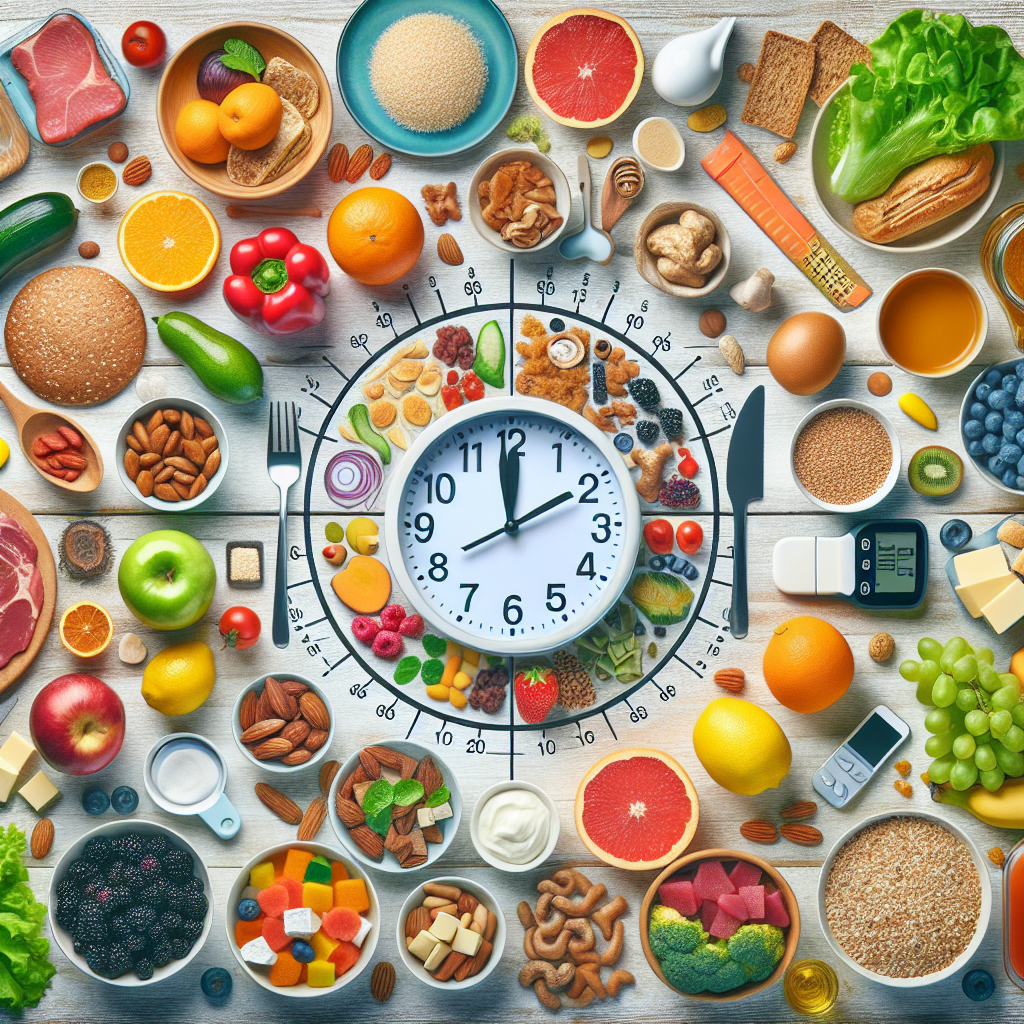Are you a diabetic looking to optimize your eating schedule? In this article, we will explore the question that plagues many individuals living with diabetes: What is the best eating schedule for diabetics? Whether you have recently been diagnosed or have been managing your condition for years, finding the right eating routine can have a significant impact on your blood sugar levels and overall well-being. Join us as we delve into the world of diabetes management and uncover some valuable insights to help you create a balanced and effective eating schedule.

Importance of a Regular Eating Schedule for Diabetics
Maintaining a regular eating schedule is crucial for individuals living with diabetes. A consistent eating schedule helps stabilize blood sugar levels and ensures proper management of this chronic condition. When you have diabetes, your body does not properly regulate blood sugar levels, causing them to fluctuate throughout the day. By following a regular eating schedule, you can help prevent these fluctuations and reduce the risk of complications associated with diabetes.
One of the main reasons why a regular eating schedule is crucial for diabetics is its impact on blood glucose levels. When you consume food, your body breaks down carbohydrates into glucose, which is then absorbed into your bloodstream. This results in an increase in blood sugar levels. By spreading your meals and snacks evenly throughout the day, you can prevent sudden spikes and drops in blood glucose levels, maintaining a more stable and controlled range.
Furthermore, having a regular eating schedule helps with portion control and weight management. When you have a consistent routine, you are more likely to eat balanced meals and avoid overeating or skipping meals. This is particularly important for diabetics, as maintaining a healthy weight is essential for managing blood sugar levels and reducing the risk of complications such as heart disease and nerve damage.
Factors to Consider When Planning an Eating Schedule
When planning an eating schedule for diabetics, it is important to consider various factors that can affect blood sugar levels and overall health. These factors include the type of diabetes, medication and insulin regimen, activity level, personal preferences, and any other underlying medical conditions.
For individuals with type 1 diabetes, who require insulin injections or an insulin pump to regulate blood sugar levels, it is crucial to align meal times with insulin administration. This ensures that the insulin is properly utilized and that blood sugar levels remain balanced. On the other hand, individuals with type 2 diabetes may need to focus more on portion control and carbohydrate intake, as their bodies may still produce insulin, but not in sufficient amounts or effectively.
Additionally, considering your activity level is vital when planning meals and snacks. Physical activity can affect blood sugar levels, and it is important to time your food intake accordingly. If you are planning to engage in physical exercise, having a snack or small meal containing carbohydrates and protein before and after the activity can help maintain stable blood sugar levels and provide fuel for your workout.
Lastly, personal preferences should be taken into account when creating an eating schedule. It is essential to find a plan that fits your lifestyle, taste preferences, cultural background, and dietary restrictions. This will ensure that you are more likely to stick to the eating schedule and maintain a healthy approach to managing your diabetes.
Recommended Meal Frequency for Diabetics
The recommended meal frequency for diabetics typically involves three main meals and two to four snacks throughout the day. This approach helps maintain a stable blood sugar level and prevents excessive hunger or overeating. Spacing out meals and snacks ensures that your body receives a steady supply of nutrients and energy.
For breakfast, lunch, and dinner, it is important to include a balance of carbohydrates, proteins, and healthy fats. Carbohydrates provide the main source of energy and should be carefully managed to prevent blood sugar spikes. Including lean proteins such as chicken, fish, tofu, or beans can help stabilize blood sugar levels and enhance satiety. Healthy fats from sources like avocado, nuts, and olive oil can help slow down the digestion of carbohydrates, preventing sudden rises in blood sugar levels.
Snacks can be planned in between meals to prevent hypoglycemia (low blood sugar) and curb hunger. These snacks should also include a combination of carbohydrates and proteins to provide sustained energy. Examples of diabetic-friendly snacks include a small apple with peanut butter, Greek yogurt with berries, or a handful of almonds with a piece of fruit.
The Benefits of Eating Small, Frequent Meals
There are numerous benefits to eating small, frequent meals for individuals with diabetes. One of the main advantages is better blood sugar control. By spreading your meals and snacks throughout the day, you can prevent drastic fluctuations in blood glucose levels. This is particularly important for individuals with diabetes, as their bodies struggle to process glucose efficiently.
Eating smaller, more frequent meals also helps manage hunger and prevent overeating. When you go for long periods without food, you are more likely to become excessively hungry and make less healthy food choices. By eating regular meals and snacks, you can keep hunger at bay and make more mindful choices when it comes to your food intake.
Another benefit of eating small, frequent meals is improved metabolism. When you provide your body with a steady supply of nutrients and energy throughout the day, your metabolism remains active, helping you burn calories more efficiently. This can be particularly beneficial for individuals with diabetes, as maintaining a healthy weight is essential for managing blood sugar levels and reducing the risk of complications.

The Pros and Cons of Intermittent Fasting for Diabetics
Intermittent fasting has gained popularity in recent years as an eating pattern that involves alternating periods of fasting and eating. While intermittent fasting may have some benefits for certain individuals, it is important to approach it with caution as a diabetic.
One potential benefit of intermittent fasting for diabetics is weight loss. By restricting eating to specific time windows, individuals may naturally reduce their caloric intake and subsequently lose weight. For individuals with type 2 diabetes who are overweight or obese, weight loss can greatly improve blood sugar control and insulin sensitivity.
However, there are also potential risks and challenges associated with intermittent fasting for diabetics. Irregular meal schedules can make it difficult to manage blood sugar levels, especially if insulin or other diabetes medications are required. Fasting periods can lead to hypoglycemia or low blood sugar, which can be dangerous for diabetics. Additionally, individuals who rely on consistent meal times to properly regulate their insulin may find intermittent fasting disruptive to their routine.
Before embarking on intermittent fasting as a diabetic, it is crucial to consult with a healthcare professional or a registered dietitian who specializes in diabetes management. They can provide personalized guidance and help determine if intermittent fasting is suitable for your individual needs and diabetes management plan.
Strategies for Creating a Balanced Diabetic Eating Schedule
Creating a balanced diabetic eating schedule involves incorporating a variety of nutritious foods in appropriate portion sizes and spacing out meals and snacks throughout the day. Here are some strategies to help you achieve a balanced approach to managing your diabetes through your eating schedule:
-
Plan your meals and snacks in advance: Take the time to plan out your meals and snacks for the week. This can help you ensure that you have a variety of nutritious options on hand and prevent last-minute unhealthy food choices.
-
Focus on portion control: Pay attention to portion sizes to manage your carbohydrate intake. Use measuring utensils or containers to ensure you are consuming appropriate amounts of food.
-
Include a variety of food groups: Aim to include a combination of carbohydrates, lean proteins, and healthy fats in each meal and snack. This will provide a balance of nutrients and help stabilize blood sugar levels.
-
Eat mindfully: Avoid distractions while eating and take the time to savor and enjoy your meals. Eating slowly and being present can help you recognize feelings of fullness and prevent overeating.
-
Stay hydrated: Drink plenty of water throughout the day to stay hydrated. Dehydration can affect blood glucose levels and overall health.
Remember, it is important to work with a healthcare professional or registered dietitian to create an eating schedule that is tailored to your specific needs and diabetes management goals.

Balancing Carbohydrate Intake Throughout the Day
Balancing carbohydrate intake throughout the day is essential for individuals with diabetes. Carbohydrates have the most significant impact on blood glucose levels, so managing their consumption is key to maintaining stable blood sugar levels.
When planning your meals and snacks, it is important to choose carbohydrates that have a low glycemic index (GI). The glycemic index measures how quickly a carbohydrate-containing food raises blood sugar levels. Foods with a low GI are digested more slowly, resulting in a slower increase in blood glucose levels.
It is also important to consider portion sizes when consuming carbohydrates. Measuring carbohydrates, whether through measuring utensils, food scales, or utilizing carbohydrate counting, can help ensure you are consuming appropriate amounts to prevent blood sugar spikes.
Timing is another important aspect of balancing carbohydrate intake throughout the day. Spacing out your carbohydrate intake can help prevent sudden rises in blood sugar levels. Distributing your carbohydrates evenly across meals and snacks can help maintain stable blood sugar control and provide sustained energy throughout the day.
Incorporating Protein and Healthy Fats into Diabetic Meals
In addition to managing carbohydrate intake, it is important to incorporate lean proteins and healthy fats into diabetic meals. Protein and healthy fats can help stabilize blood sugar levels, enhance satiety, and provide essential nutrients.
Including lean sources of protein such as chicken, fish, tofu, eggs, and legumes in your meals can help slow down the digestion of carbohydrates, preventing sudden increases in blood sugar levels. Protein also helps regulate hunger hormones and can keep you feeling satisfied between meals.
Healthy fats, such as those found in avocados, nuts, seeds, and olive oil, are important for overall health and blood sugar management. They can help slow down the absorption of carbohydrates, preventing blood sugar spikes, and providing a source of sustained energy. It is important to consume these fats in moderation, as they are dense in calories.
Aim to include a serving of lean protein and a small amount of healthy fat in each meal. This can be achieved through incorporating ingredients like grilled chicken breast with a side salad dressed with olive oil, or a serving of roasted salmon with steamed vegetables and a sprinkle of nuts.

The Role of Fiber in a Diabetic Eating Schedule
Fiber plays a crucial role in a diabetic eating schedule. It is a type of carbohydrate that is not digested by the body, meaning it does not significantly impact blood sugar levels. Instead, fiber provides numerous health benefits and can help with blood sugar control, weight management, and heart health.
There are two types of fiber: soluble fiber and insoluble fiber. Soluble fiber forms a gel-like substance when dissolved in water and helps slow down the digestion of carbohydrates, preventing sudden spikes in blood sugar levels. Insoluble fiber adds bulk to stool and aids in digestion, helping to regulate bowel movements and prevent constipation.
Including high-fiber foods in your meals and snacks can help promote satiety and support healthy blood sugar levels. Examples of high-fiber foods include fruits, vegetables, whole grains, legumes, and nuts. When adding fiber to your diet, it is important to do so gradually and drink plenty of water to prevent digestive discomfort.
Aim to include a variety of high-fiber foods in your daily meals and snacks. For example, you could add fresh berries to your breakfast oats, include a side of steamed vegetables with your lunch, snack on raw carrots or celery with hummus, and incorporate whole grain options such as quinoa or whole wheat bread into your meals.
Timing Meals and Snacks around Medication and Exercise
When living with diabetes, timing your meals and snacks around medication and exercise is essential to ensure proper blood sugar management.
If you are taking oral medications or insulin injections, it is important to coordinate your meals and snacks with your medication regimen. Certain medications need to be taken with food to prevent hypoglycemia, while others may require you to wait a certain amount of time before or after eating. Consult with your healthcare professional or pharmacist to understand how your medications should be timed with your meals.
Timing your meals and snacks around exercise is crucial for maintaining stable blood sugar levels and preventing hypoglycemia or hyperglycemia. Before engaging in physical activity, it is recommended to have a snack or small meal that includes both carbohydrates and protein to provide sustained energy. Checking your blood sugar levels before and after exercise can help you understand how your body responds to different activity levels and adjust your eating schedule accordingly.
If you take medications that lower blood sugar, such as insulin, it is important to monitor your blood sugar levels during and after exercise to prevent hypoglycemia. Adjusting your medication doses or consuming additional snacks may be necessary to ensure your blood sugar remains within a safe range.
By coordinating your meals, snacks, medication, and exercise, you can optimize your blood sugar management and overall health as a diabetic.
In conclusion, maintaining a regular eating schedule is essential for individuals living with diabetes. By following a consistent eating routine, considering various factors, incorporating a balance of nutrients, and timing meals and snacks appropriately, you can effectively manage your blood sugar levels and support overall health. Remember to consult with a healthcare professional or registered dietitian for personalized guidance and to ensure you are meeting your individual needs as a diabetic.

